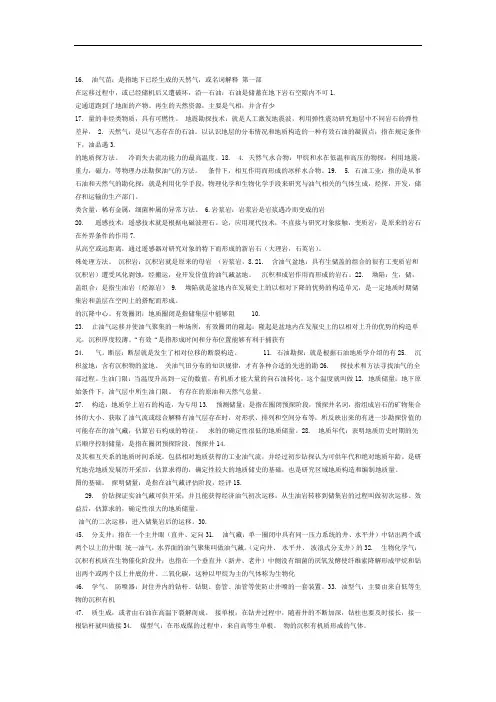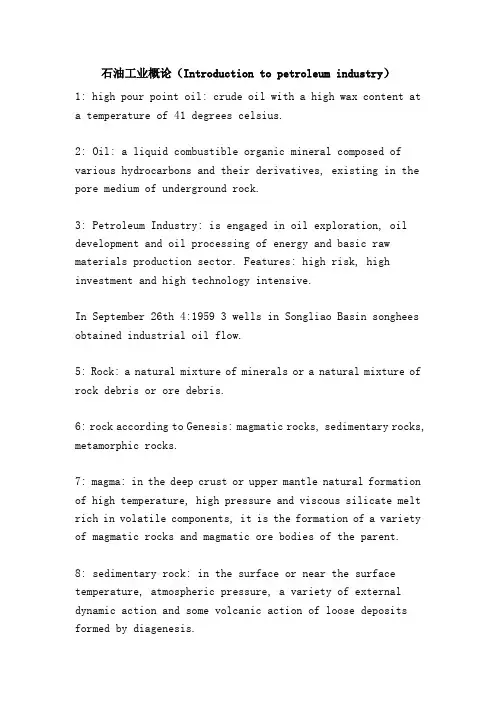石油工业概论answer精编
石油工业概论answer

石油工业概论answer一讲石油工业的发展历程1单选(2分)我国古代哪项发明被称为继我国古代第四大发明之后的第五大发明( D ) A.康盆采气术B.木制管道C.猛火油术D.顿钻2单选(2分)战争史上第一次利用汽车大规模机动兵力发生在( C )A.伦敦B.纽约C.巴黎D.莫斯科3多选(3分)为什么德雷克井成为近代世界石油工业的标志?ACA.这口井迅速带动产生了一个完整的石油工业体系。
B.是近代世界钻出的第一口油井。
C.是第一口用机器钻成、用机器采油的井。
D.德雷克是第一代的钻井公司经理。
4多选(3分)第一次世界大战后,导致石油成为战略物资的原因(AD )A.飞机的出现B.机枪大炮的出现C.火箭的出现D.坦克的出现5判断(2分)唐朝时期,我国建立了世界上最早的炼油车间一一“猛火油作”。
AA.错B.对6判断(2分)坦克是由英国人发明的。
AA.对B错7填空(2分)我国古代在石油科技领域拥有顿钻、康盆采气术、()、猛火油术四大发明正确答案:木制管道1单选(2分)我国古代哪项发明被称为继我国古代第四大发明之后的第五大发明( BA.木制管道B.顿钻C.猛火油术D.康盆采气术2单选(2分)(D )公司首创通过开办娱乐节目来促进油品销售。
A.英国石油公司B.埃克森石油公司C.海湾石油公司D.德士古石油公司3多选(3分)石油工业的上游指的是(AB )A.开发石油部门B.勘探石油部门C.石油化工部门D.炼制石油部分4多选(3分)为什么德雷克井成为近代世界石油工业的标志?ACA.这口井迅速带动产生了一个完整的石油工业体系。
B.是近代世界钻出的第一口油井。
C.是第一口用机器钻成、用机器采油的井。
D.德雷克是第一代的钻井公司经理。
5判断(2分)唐朝时期,我国建立了世界上最早的炼油车间一一“猛火油作”。
BA.对B.错6判断(2分)坦克是由英国人发明的。
AA.对B.错7填空(2分)标准石油公司成立于(1870 )年。
正确答案:18708填空(2分)(法)国大发明家克雷曼•阿德首次提出了航母的基本概念和制造航母的初步设想。
石油工业概论在线考试答案

5、石油化工包括哪三大生产过程?
答:石油化工包括以下三大生产过程:
(1)基本有机化工生产过程。基本有机化工生产过程是以石油和天然气为起始原料,经过炼制加工制得三烯(乙烯、丙烯、丁烯)、三苯(苯、甲苯、二甲苯)、乙炔和萘等基本有机原料的过程;
(2)有机化工生产过程。有机化工生产过程是在“三烯、三苯、乙炔、萘”的基础上,通过各种合成步骤制取醇、醛、酮、酸、醚、腈等有机原料的过程;
二、简答题(50分,每题10分)
1、1986年的石油危机产生的原因?
答:20世纪80年代以后,石油价格的猛涨刺激了石油工业的投资,随即又发现了一大批油田,非欧佩克组织的石油产量迅速增加,一度超过了欧佩克国家。由于欧佩克国家坚守原油价格不降的原则,卖出的原油越来越少,所以为了保住市场,欧佩克国家采用了降价销售的方式。随着石油输出国组织团体力量的瓦解以及新型产油国的出现,石油权利开始分散。1986年,石油价格降到10美元/桶以下,使国际石油市场出现混乱,对世界经济和金融体系产生猛烈冲击,第三次石油危机爆发。
答:(1)动力系统:包括为钻机提供动力的柴油机组、发电机组、电动机、传动箱、并车箱、液气传输管阀、空气压缩机等。
(2)起升系统:主要由井架、天车、游车、大绳、大钩、吊环及绞车等组成。
(3)旋转系统:主要由转盘、转盘变速箱、水龙头、方钻杆组成。
(4)循环系统:主要包括泥浆泵、泥浆净化装置(固相控制设备)和泥浆槽、罐等。
2、生成油气的条件有哪些?
答:(1)古地理环境与地质条件:①长期被淹没的水体;②离岸近的地区;③浅海(湖)地区; ④稳定的水体; ⑤地壳长期稳定沉降,而且沉降幅度应与沉积物补偿的速度大体一致。(2)物理化学条件:①细菌作用;②温度与时间;③压力作用;④催化剂作用;⑤放射性作用。
石油工业概论题库加答案

石油工业概论题库加答案Document number【AA80KGB-AA98YT-AAT8CB-2A6UT-A18GG】第一部名词解释1.石油:石油是储蓄在地下岩石空隙内不可再生的天然资源,主要是气相,并含有少量的非烃类物质,具有可燃性。
2.天然气:是以气态存在的石油。
3.石油的凝固点:指在规定条件下,油品遇冷而失去流动能力的最高温度。
4.天然气水合物:甲烷和水在低温和高压的条件下,相互作用而形成的冰样水合物。
5.石油工业:指的是从事石油和天然气的勘探,开发,储存和运输的生产部门。
6.岩浆岩:岩浆岩是岩浆遇冷而变成的岩石。
7.变质岩:是原来的岩石在外界条件的作用下而形成的新岩石(大理岩,石英岩)。
8.沉积岩:沉积岩就是原来的母岩(岩浆岩,变质岩和沉积岩)遭受风化剥蚀,经搬运,沉积和成岩作用而形成的岩石。
9.生,储,盖组合:是指生油岩(烃源岩)储集岩和盖层在空间上的搭配而形成。
10. 有效圈闭:地质圈闭是指储集层中能够阻止油气运移并使油气聚集的一种场所,有效圈闭的“有效“是指形成时间和分布位置能够有利于捕获有气。
11. 石油勘探:就是根据石油地质学介绍的有关油气田分布的知识规律,才有各种合适的先进的勘探技术和方法寻找油气的全部过程。
12. 地质储量:地下原始条件下,油气层中所有存在的原油和天然气总量。
13. 预测储量:是指在圈闭预探阶段,预探井获取了油气流或综合解释有油气层存在时,对有进一步勘探价值的可能存在的油气藏,估算求的的确定性很低的地质储量。
14. 控制储量:是指在圈闭预探阶段,预探井获得的工业油气流,并经过初步钻探认为可供开采后,估算求得的,确定性较大的地质储量。
15. 探明储量:是指在油气藏评估阶段,经评价钻探证实油气藏可供开采,并且能获得经济效益后,估算求的,确定性很大的地质储量。
16. 油气苗:是指地下已经生成的天然气,或在运移过程中,或已经储机后又遭破坏,沿一定通道跑到了地面的产物。
石油工业概论题库加答案新编

16. 油气苗:是指地下已经生成的天然气,或名词解释第一部在运移过程中,或已经储机后又遭破坏,沿一石油:石油是储蓄在地下岩石空隙内不可1.定通道跑到了地面的产物。
再生的天然资源,主要是气相,并含有少17. 量的非烃类物质,具有可燃性。
地震勘探技术:就是人工激发地震波,利用弹性震动研究地层中不同岩石的弹性差异,2.天然气:是以气态存在的石油。
以认识地层的分布情况和地质构造的一种有效石油的凝固点:指在规定条件下,油品遇3.的地质探方法。
冷而失去流动能力的最高温度。
18. 4.天然气水合物:甲烷和水在低温和高压的物探:利用地震,重力,磁力,等物理办法勘探油气的方法。
条件下,相互作用而形成的冰样水合物。
19. 5.石油工业:指的是从事石油和天然气的勘化探:就是利用化学手段,物理化学和生物化学手段来研究与油气相关的气体生成,烃探,开发,储存和运输的生产部门。
类含量,稀有金属,细菌种属的异常方法。
6.岩浆岩:岩浆岩是岩浆遇冷而变成的岩20. 遥感技术:遥感技术就是根据电磁波理石。
论,应用现代技术,不直接与研究对象接触,变质岩:是原来的岩石在外界条件的作用7.从高空或远距离,通过遥感器对研究对象的特下而形成的新岩石(大理岩,石英岩)。
殊处理方法。
沉积岩:沉积岩就是原来的母岩(岩浆岩,8.21. 含油气盆地:具有生储盖的组合的很有工变质岩和沉积岩)遭受风化剥蚀,经搬运,业开发价值的油气藏盆地。
沉积和成岩作用而形成的岩石。
22. 坳陷:生,储,盖组合:是指生油岩(烃源岩)9. 坳陷就是盆地内在发展史上的以相对下降的优势的构造单元,是一定地质时期储集岩和盖层在空间上的搭配而形成。
的沉降中心。
有效圈闭:地质圈闭是指储集层中能够阻 10.23. 止油气运移并使油气聚集的一种场所,有效圈闭的隆起:隆起是盆地内在发展史上的以相对上升的优势的构造单元,沉积厚度较薄。
“有效“是指形成时间和分布位置能够有利于捕获有24. 气。
断层:断层就是发生了相对位移的断裂构造。
石油工业概论题库及答案精编版

石油工业概论题库及答案GE GROUP system office room 【GEIHUA16H-GEIHUA GEIHUA8Q8-第一章绪论一基本概念1.石油:石油是储藏在地下岩石空隙内的不可再生的天然矿产资源,它主要是以气相、液相和固相烃类为主的,并且含有少量非烃类物质的混合物,具可燃性。
2.石油基本性质:①主要化学成分:C和H,其中C占84%~87%,H占11%~14%。
烃类化合物有:烷烃、环烷烃、芳香烃。
②非烃类化合物有:含硫化合物、含氮化合物、含氧化合物。
③密度:比水轻,相对密度一般在0.75~0.95之间。
④颜色浅的原油一般密度小,粘度低,油中含轻烃成分较多;含胶质和沥青质少,密度小。
⑤粘度:随温度的增高而减小,随密度的减小而减小。
含烷烃多的原油黏度较小;含胶质、沥青质多的原油粘度较大。
⑥凝固点:原油含蜡越多,凝点越高。
⑦闪点、燃点、自然点:原油和成品油越轻,其闪点和燃点月底,而自燃点却越高。
⑧溶解性:不溶于水,能溶于有机溶剂(如氯仿、四氯化碳、苯、醇等)。
⑨原油中的有害物质。
3.天然气的成分:主要是气态烃,以甲烷为主,其中还有少量的C2-C5烷烃成分及非烃气体。
气密度一般在0.5-0.7之间,比空气轻。
4.天然气水合物:又称可燃冰,是甲烷和水在低温和高压环境下相互作用形成的一种冰状的水合物。
5.液化天然气(LNG);液化天然气是天然气经经净化处理后,通过低温冷却而成的液态产物,气体积为原气态体积1/600。
6.天然气分类:按照矿藏特点,可分为气藏气、油藏气、凝析气藏气;按烃类的组成,可分为干气、湿气;按硫化氢和二氧化碳的含量,可分为酸气、净气。
7.石油工业:从事石油和天然气的勘探、开发、储存和运输等的生产部门统称为石油工业。
8.对外依存度:是指一个国家原油净进口量占本国原油消费量的比例,表现一个国家原油消费数量对国外原油的依赖程度。
常用来描述原油安全的程度。
9.储采比:又称回采率或回采比。
石油工业概论(Introduction to petroleum industry)

石油工业概论(Introduction to petroleum industry)1: high pour point oil: crude oil with a high wax content at a temperature of 41 degrees celsius.2: Oil: a liquid combustible organic mineral composed of various hydrocarbons and their derivatives, existing in the pore medium of underground rock.3: Petroleum Industry: is engaged in oil exploration, oil development and oil processing of energy and basic raw materials production sector. Features: high risk, high investment and high technology intensive.In September 26th 4:1959 3 wells in Songliao Basin songhees obtained industrial oil flow.5: Rock: a natural mixture of minerals or a natural mixture of rock debris or ore debris.6: rock according to Genesis: magmatic rocks, sedimentary rocks, metamorphic rocks.7: magma: in the deep crust or upper mantle natural formation of high temperature, high pressure and viscous silicate melt rich in volatile components, it is the formation of a variety of magmatic rocks and magmatic ore bodies of the parent.8: sedimentary rock: in the surface or near the surface temperature, atmospheric pressure, a variety of external dynamic action and some volcanic action of loose deposits formed by diagenesis.9: fossil: rocks and sediments preserved in geological history.10: vitrinite reflectance: the percentage of vertical intensity of incident light reflected by vitrinite (Lv Guangzhong).11: kerogen: dispersed sedimentary organic matter in source rock and sedimentary rock, insoluble in alkali, non oxidizing acid and non-polar organic solvent.12: Trap: refers to the reservoir can prevent oil and gas migration and accumulation of oil and gas sites. It consists of reservoir, cover and shelter.13: the power of oil and gas migration: 1): 1. The primary migration of compaction compaction and increase the effect of dialysis fluid thermal hydrocarbon generation effect of the clay mineral dehydration and organic matter; 2) the two movement: the hydrodynamic buoyancy of the tectonic movement.14: geothermal gradient: increasing temperature at an increase of 100 m per depth.15:: at the Moho below the surface of a few kilometers to 40km +, the longitudinal wave reaches the interface, the average speed by 6 ~ 7km/s, jumped to 8.1km/s.16:: 2900km is located at a depth of underground gutenberg. The shear wave disappears at this interface and the longitudinal wave passes through it.17: tectonic movement: mechanical movement caused by the internal forces of the earth to cause deformation and displacement of the earth's crust and even the lithosphere.18:: geological structure composition of the crust rock or rock mass stress and deformation, deformation of left traces.19: fold: a series of bends resulting from the action of tectonic movements.20: anticline: the formation of rock arching upward, forming a central part of the older strata, rock layers on both sides turn new21: syncline: the downward bending of the rock layer, the central part of the new rock formation, the rocks on both sides of the rock in turn aging.22: fracture structure: rock under the action of external force rupture.23: joint: there is no obvious displacement fracture after rock rupture, and it is the most widespread and common fracture structure.24: fault: significant relative displacement of rocks occurs on both sides of rock after fracture.25: normal fault: the relative depression of the upper plate and the relative rise of the footwall.26: reverse fault: the upper plate rises relatively and the footwall decreases relatively.27: translational faults: rocks on both sides of faults,A fault that moves relative to the horizontal plane of the fault.28: Horst: is composed of two or more to the consistent tendency is opposite relative fault, rise in the central part of both sides of the relative decline of the structure.29: graben: it is composed of two or more normal strike faults, the central part of which is relatively declining, and the relative rising structures on both sides.30: Mineral: it is a natural element or compound formed by geological action. It has certain chemical and physical properties.31: stratum: a layer or group of rocks in a certain layer of the earth's crust.32: sedimentary rocks are deposited successively and sequentially, so the normal strata are old and new.33: oil threshold: organic matter began to produce large amounts of oil depth.34: source rocks: rocks that are capable of generating oil andgas and capable of discharging oil and gas.35: a brief account of the formation of sedimentary rocks. Weathering: the mechanical disintegration and chemical decomposition of rock after external force destroy the basic residue of the product, and the hard rock becomes loose debris and soil. Denudation: the rock is destroyed by the external force and the product is removed at the same time. Transportation function: to transport weathered and denuded substance to it. Deposition: the sediment is deposited where conditions are appropriate. Consolidation diagenesis: the transition from loose sediments into solid sedimentary rocks.36: a brief description of the relationship between the three rocks. Answer: igneous rocks and metamorphic rocks are weathered, eroded, transported and accumulated to form sedimentary rocks. Magmatic rocks and sedimentary rocks are metamorphosed into metamorphic rocks,Magmatic rocks, sedimentary rocks and metamorphic rocks are formed by remelting into magma, and magma is condensed to form magmatic rocks.37: briefly describes the geological and physical and chemical conditions for oil and gas formation. Answer: a geological environment: the tectonic conditions of sedimentary basins: a long and steady decline; the lithofacies paleogeographic conditions: proper depth and larger area, rich in organic matter in water and energy reduction environment; the ancient climate conditions: reproduction and development of warm and moist climate conducive to biological science; two condition:temperature and time: two in a certain range of complementary; bacterial action: itself as a source of raw material and the decomposition of organic matter, corresponding organic compounds and methane gas; the catalytic role: is the main clay mineral and yeast; the effect of local temperature: radioactive radioactive elements due to the increased thermal evolution of organic matter to.38: the geotectonic condition is fundamental, and it controls lithofacies, palaeogeography and paleoclimate characteristics.39: the evolution of organic matter and hydrocarbon generation model are discussed.40: reservoir: rock formations where reservoirs can be stored and percolating.41: caprock: a poorly permeable, sealed, upward loss reservoir over a reservoir.42: oil and gas reservoirs: oil and gas in a single trap, with independent pressure system and a unified interface between the basic accumulation of oil and water.43: oil and gas migration: the movement of oil and gas in the earth crust under the influence of various natural factors.44: oil and gas fields: the total reservoir, gas reservoir and oil pool controlled by the same local tectonic area.Oil and gas fields, oil and gas basins?45: what are the motive forces for the initial migration of oil and gas? Answer: the compaction, the compaction, the thermal fluid pressure, the clay mineral dehydration, hydrocarbon generation and organic matter, the effect of dialysis.46: discuss the accumulation conditions of oil and gas reservoirs. Answer: 1. Sufficient source of oil and gas; 2. Having favorable source and reservoir cap assemblages; 3. Having effective traps; and having necessary preservation conditions.47: briefly describe the accumulation of oil and gas in a single trap: Taking anticline trap as an example. Answer: under hydrostatic condition, if oil and gas Everfount into traps, the process of oil and gas accumulation in a single trap can be divided into three stages: the first: oil and gas in the dip direction under the effect of buoyancy migrating to traps, traps for oil and gas accumulation, the original occupy trap water is discharged in part, due to the gravity function, gas, oil and water. Second: the number of oil and gas continues to increase, oil and water interface has dropped to the point of overflow, but the number of oil and gas is still increasing, some of the oil from the overflow point along the upward direction of overflow, the volume of the gas top increased, the oil was squeezed out. Third: when oil and gas continue to enter the trap, gas occupies the upper, oil and gas to natural gas migration, until all the traps, the oil will no longer enter the trap, but along the overflow point to the updip direction to the spill, traps were filled with natural gas.What are the tasks and characteristics of 48: oil and gas exploration? Answer: 1 tasks: oil and gas field exploration is based on the theory of oil and gas generation, formation of oil and gas reservoirs and distribution law of oil and gas fields in petroleum geology,The exploration of advanced management through the implementation of the scientific exploration program, the use of technical methods, appropriate, to achieve economic, effective and quick find and discover the oil and gas fields, proven geological reserves of oil and gas and find out the basic situation of oil and gas, which is required to obtain all the oilfield development data for oil and gas development to prepare for a system engineering purpose. 2 characteristics: 1: regional oil and gas reservoir, is often not a single isolated, but distribute in groups or belts, the comprehensive sequential exploration work procedure and work method, the cycle: according to the project management organization, application of multi discipline, system engineering work, the implementation of collaborative work stage.What are the basic methods for the exploration of 49: oil and gas fields? Answer: ground survey method, remote sensing of oil and gas resources, geochemical exploration.50: what are the proven geological reserves, the control of geological reserves and the prediction of geological reserves? Answer: the forecast reserves: refers to the stage of preliminary exploration of traps wildcat obtained oil and gas or oil and gas comprehensive interpretation exists, to have afurther exploration value, existing oil and gas reserves, estimated by the uncertainty, very low. The proven reserves: refers to the stage of oil and gas reservoir evaluation, the evaluation of oil and gas drilling confirmed can provide mining and can obtain economic benefits after the great uncertainty, estimated geological reserves, and the relative error is less than 20%. The control reserves: refers to the stage of preliminary exploration of traps pre exploration wells to obtain industrial oil and gas, and after the initial drilling that can provide mining, estimated and uncertain large geological reserves, and the relative error is less than 50%.51: classification of drilling: 1 exploration wells and production wells, 2 vertical wells and directional wells.52: exploration well: in order to obtain geological data.53: producing well: it is a well drilled for oilfield production during oilfield development stage.54: turntable drilling ground to use a set of equipment, underground also use a set of drilling tools, this drilling tool includes well drill pipe, drill pipe, drill collar and so on.55: drill string: in drilling, the pipe string is formed by connecting the Kelly pipe, the drill rod and the drill collar with the joint.56: Cementing: the casing is inserted into the casing in the well under the well, and the cement is sealed between the casing and the shaft wall.57: heavy oil58: methods to increase oil recovery59: classification of gas fields60: stone oil refining or petroleum technology 61: distillation of crude oil (primary processing) 62: cracking63: gasoline label64: Petrochemical Industry。
石油工业概论
石油工业概论1. 石油,这个黑色的宝贝,大家都说它是"工业的血液"。
咱们今天就来聊聊这个让全世界都为之疯狂的"黑金"。
2. 记得上次跟老王聊天,他说:"你知道吗,咱们用的汽油、柴油,甚至是身上穿的衣服,都离不开石油!"没错,石油就是这么神奇,它就像是变魔术的材料,可以变成各种各样的东西。
3. 石油是怎么形成的呢?想象一下,几百万年前,海洋里的小生物和植物慢慢沉积到海底,在高温高压下,经过漫长的时间,就变成了现在的石油。
就像是地球给我们煮了一锅超级久的"生物汤"。
4. 石油工业可不简单,它包括了勘探、开采、炼制和销售这几大环节。
勘探就像是地球的体检,要用各种仪器去"摸摸"地下到底藏着多少石油;开采就像是给地球"打针",用钻井设备把石油抽出来。
5. 有趣的是,现在的石油工人可不是用铁锹挖石油。
他们用的是超级先进的设备,像是三维地震勘探技术,就跟给地球做个全身扫描似的,能清清楚楚看到地下的情况。
6. 炼油厂就更有意思了,它就像是个超级大厨房。
原油进去后,经过加热、蒸馏、裂化等工序,就能变成汽油、柴油、煤油等产品。
老张常说:"这就像是把一锅乱炖分成好几道菜。
"7. 石油工业还特别讲究环保。
现在的石油企业都在想办法减少污染,就像是做菜的时候要注意收拾厨房一样。
有的企业还研发了清洁能源技术,真是既要吃饱,还要吃得健康。
8. 说到石油价格,那可真是世界级的"过山车"。
涨起来的时候让人心惊胆战,跌下去的时候又让人措手不及。
小李前几天还跟我说:"这油价比股市还刺激!"9. 石油储量是个大问题。
科学家们预测,按照目前的开采速度,全球石油储量可能再用个几十年就要见底了。
这就像是家里的零食,再多也总有吃完的一天。
所以,现在各国都在发展新能源。
石油工业概论题库加答案新编精修订
石油工业概论题库加答案新编GE GROUP system office room 【GEIHUA16H-GEIHUA GEIHUA8Q8-第一部名词解释1.石油:石油是储蓄在地下岩石空隙内不可再生的天然资源,主要是气相,并含有少量的非烃类物质,具有可燃性。
2.天然气:是以气态存在的石油。
3.石油的凝固点:指在规定条件下,油品遇冷而失去流动能力的最高温度。
4.天然气水合物:甲烷和水在低温和高压的条件下,相互作用而形成的冰样水合物。
5.石油工业:指的是从事石油和天然气的勘探,开发,储存和运输的生产部门。
6.岩浆岩:岩浆岩是岩浆遇冷而变成的岩石。
7.变质岩:是原来的岩石在外界条件的作用下而形成的新岩石(大理岩,石英岩)。
8.沉积岩:沉积岩就是原来的母岩(岩浆岩,变质岩和沉积岩)遭受风化剥蚀,经搬运,沉积和成岩作用而形成的岩石。
9.生,储,盖组合:是指生油岩(烃源岩)储集岩和盖层在空间上的搭配而形成。
10. 有效圈闭:地质圈闭是指储集层中能够阻止油气运移并使油气聚集的一种场所,有效圈闭的“有效“是指形成时间和分布位置能够有利于捕获有气。
11. 石油勘探:就是根据石油地质学介绍的有关油气田分布的知识规律,才有各种合适的先进的勘探技术和方法寻找油气的全部过程。
12. 地质储量:地下原始条件下,油气层中所有存在的原油和天然气总量。
13. 预测储量:是指在圈闭预探阶段,预探井获取了油气流或综合解释有油气层存在时,对有进一步勘探价值的可能存在的油气藏,估算求的的确定性很低的地质储量。
14. 控制储量:是指在圈闭预探阶段,预探井获得的工业油气流,并经过初步钻探认为可供开采后,估算求得的,确定性较大的地质储量。
15. 探明储量:是指在油气藏评估阶段,经评价钻探证实油气藏可供开采,并且能获得经济效益后,估算求的,确定性很大的地质储量。
16. 油气苗:是指地下已经生成的天然气,或在运移过程中,或已经储机后又遭破坏,沿一定通道跑到了地面的产物。
石油工业概论swer精编
石油工业概论s w e r精编Document number:WTT-LKK-GBB-08921-EIGG-22986一讲石油工业的发展历程1单选(2分)我国古代哪项发明被称为继我国古代第四大发明之后的第五大发明( D )A.康盆采气术B.木制管道C.猛火油术D.顿钻2单选(2分)战争史上第一次利用汽车大规模机动兵力发生在( C )A.伦敦B.纽约C.巴黎D.莫斯科3多选(3分)为什么德雷克井成为近代世界石油工业的标志ACA.这口井迅速带动产生了一个完整的石油工业体系。
B.是近代世界钻出的第一口油井。
C.是第一口用机器钻成、用机器采油的井。
D.德雷克是第一代的钻井公司经理。
4多选(3分)第一次世界大战后,导致石油成为战略物资的原因( AD )A.飞机的出现B.机枪大炮的出现C.火箭的出现D.坦克的出现5判断(2分)唐朝时期,我国建立了世界上最早的炼油车间——“猛火油作”。
AA.错B.对6判断(2分)坦克是由英国人发明的。
AA.对B错7填空(2分)我国古代在石油科技领域拥有顿钻、康盆采气术、()、猛火油术四大发明。
正确答案:木制管道1单选(2分)我国古代哪项发明被称为继我国古代第四大发明之后的第五大发明( B )A.木制管道B.顿钻C.猛火油术D.康盆采气术2单选(2分)( D )公司首创通过开办娱乐节目来促进油品销售。
A.英国石油公司B.埃克森石油公司C.海湾石油公司D.德士古石油公司3多选(3分)石油工业的上游指的是( AB )A.开发石油部门B.勘探石油部门C.石油化工部门D.炼制石油部分4多选(3分)为什么德雷克井成为近代世界石油工业的标志ACA.这口井迅速带动产生了一个完整的石油工业体系。
B.是近代世界钻出的第一口油井。
C.是第一口用机器钻成、用机器采油的井。
D.德雷克是第一代的钻井公司经理。
5判断(2分)唐朝时期,我国建立了世界上最早的炼油车间——“猛火油作”。
BA.对B.错6判断(2分)坦克是由英国人发明的。
石油工业概论思考题
石油工业概论思考题1.什么是石油?天然气?石油是气态、液态和固态的烃类混合物,具有天然的产状;自然界一切天然生成的气体,如大气、岩石中气体、海洋中的气体、地幔气、宇宙气等都可称之为天然气。
2.什么是石油工业?石油工业是以原油为原料所发展起来的工业体系,包括石油勘探、石油开发和石油加工的能源和基础原材料生产部门3.世界石油工业发展史?分为哪几个阶段?1878年在台湾苗栗油矿打出我国第一口油井。
1907我国打出了大陆第一口油井——延长一号井,井深80多米,日产原油1~1.5吨。
1936年春,国民党新疆地方政府与苏联政府联合开采在独山子发现油矿。
1938年地质学家孙建初在甘肃玉门发现了老君庙油田,使中国近代石油工业进入了一个新的发展阶段。
我国科学家提出“陆相成油理论”,开创我国找油新局面①煤油时代②汽油时代③燃料和化工原料时代4.中国石油工业发展史,新中国成立后石油工业发展阶段?石油名称的出处?1)勘探初期阶段2)战略东移,突破松辽盆地3)进军渤海湾,创建第二大石油基地(4)稳定东部,发展西部,油气并举,大力发展近海勘探。
加强全范围内的区域勘探;一千九百多年前东汉班固的《汉书·地理志》——“高奴(指延安)有洧(wei)水可然”——石油。
5.中国石油工业基本构成?三大石油公司名称?石油的勘探、开发、加工、运输和销售等工作中国石油天然气集团公司(CNPC)中国石油化工集团公司(SINOPEC) 中国海洋石油总公司(CNOOC)6.什么是OPEC?“欧佩克”即石油输出国组织。
它是一个自愿结成的政府间组织,对其成员国的石油政策进行协调、统一。
7、什么是环境污染?我国环境保护的管理体制?石油企业内部的环保管理体制及其任务?环境污染:由于人为的因素,环境的化学组成或物理状态发生了变化,与原来的情况相比,环境质量恶化,扰乱和破坏了生态系统和人们正常的生产和生活条件,就叫做…环境污染”。
环境保护管理体制;政府体制:国家环境保护部;省市县环保局;任务:制定政策,行政执法,监督落实;发展规划;企业内部:一般均对应政府相关机构设立相关部门;石油企业:质量安全环保部,环保处,环保科;外部协调,内部监督管理;第二章石油地质1、名词解释:储集层、盖层、圈闭、油气藏、油气田、初次运移、二次运移储集层---这些具有孔、洞、缝,能够储存和渗滤流体的岩层,称为储集层。
- 1、下载文档前请自行甄别文档内容的完整性,平台不提供额外的编辑、内容补充、找答案等附加服务。
- 2、"仅部分预览"的文档,不可在线预览部分如存在完整性等问题,可反馈申请退款(可完整预览的文档不适用该条件!)。
- 3、如文档侵犯您的权益,请联系客服反馈,我们会尽快为您处理(人工客服工作时间:9:00-18:30)。
一讲石油工业的发展历程1单选(2分)我国古代哪项发明被称为继我国古代第四大发明之后的第五大发明( D )A.康盆采气术B.木制管道C.猛火油术D.顿钻2单选(2分)战争史上第一次利用汽车大规模机动兵力发生在( C )A.伦敦B.纽约C.巴黎D.莫斯科3多选(3分)为什么德雷克井成为近代世界石油工业的标志?ACA.这口井迅速带动产生了一个完整的石油工业体系。
B.是近代世界钻出的第一口油井。
C.是第一口用机器钻成、用机器采油的井。
D.德雷克是第一代的钻井公司经理。
4多选(3分)第一次世界大战后,导致石油成为战略物资的原因( AD )A.飞机的出现B.机枪大炮的出现C.火箭的出现D.坦克的出现5判断(2分)唐朝时期,我国建立了世界上最早的炼油车间——“猛火油作”。
AA.错B.对6判断(2分)坦克是由英国人发明的。
AA.对B错7填空(2分)我国古代在石油科技领域拥有顿钻、康盆采气术、()、猛火油术四大发明。
正确答案:木制管道1单选(2分)我国古代哪项发明被称为继我国古代第四大发明之后的第五大发明( B )A.木制管道B.顿钻C.猛火油术D.康盆采气术2单选(2分)( D )公司首创通过开办娱乐节目来促进油品销售。
A.英国石油公司B.埃克森石油公司C.海湾石油公司D.德士古石油公司3多选(3分)石油工业的上游指的是( AB )A.开发石油部门B.勘探石油部门C.石油化工部门D.炼制石油部分4多选(3分)为什么德雷克井成为近代世界石油工业的标志?ACA.这口井迅速带动产生了一个完整的石油工业体系。
B.是近代世界钻出的第一口油井。
C.是第一口用机器钻成、用机器采油的井。
D.德雷克是第一代的钻井公司经理。
5判断(2分)唐朝时期,我国建立了世界上最早的炼油车间——“猛火油作”。
BA.对B.错6判断(2分)坦克是由英国人发明的。
AA.对B.错7填空(2分)标准石油公司成立于( 1870 )年。
正确答案:18708填空(2分)(法)国大发明家克雷曼?阿德首次提出了航母的基本概念和制造航母的初步设想。
正确答案:法1单选(2分)石蜡烃属于( A )。
A.烷烃B.芳香烃C.环烷烃D.非烃2单选(2分)化肥的生产需要石油里面的( C )元素。
A.氧B.碳C.氢D.氮3多选(3分)在历史上,石油的称谓有( ABCD )。
A.黑香油B.神火C.水肥D.石脑油5判断(2分)由石油生产出来的风力叶片强度和耐腐蚀性都大大优于金属,但制作成本比用金属制作的高。
AA.错B.对6判断(2分)利用聚合物,既可以生产合成橡胶,也可以生产合成纤维。
BA.错B对2单选(2分)尼龙是由()公司发明的。
A.英国石油B.埃克森石油C.德士古石油D.杜邦3多选(3分)石油里面的次要元素有( ACD )。
A.氮B.钾C.氧D.硫4多选(3分)()属于非烃化合物。
A.卟啉该题无法得分/B.沥青C.奎宁该题无法得分/D.硫酸铵该题无法得分/5判断(2分)在柴油产品中,支链烷烃抗爆性好。
AA.错B.对6判断(2分)利用聚合物,既可以生产合成橡胶,也可以生产合成纤维。
B得分/总分A.错B.对第三讲油气生成与聚集1单选(2分)生成大量石油的有机物质是( B )。
A.高等植物B.微生物C.低等动物D高等动物3多选(3分)( BCD )属于陆相。
A.三角洲相B.河流相C.沙漠相D.湖泊相4多选(3分)有机质向油气转化是一个复杂的过程,( ABCD )是必不可少的理化条件。
A.地层压力B.时间C.细菌的作用D.地层温度5多选(3分)( ABC )可作为烃源岩。
A.页岩B.泥岩C.灰岩D.砂岩6判断(2分)一个没有生命存在的星球,它的表面物理动态也近乎于停滞。
BA.错B.对7判断(2分)所有的岩石都有可能成为储集岩。
BA.错B.对8判断(2分)油气初次运移的方向是多方位的,可以向上、向下或向四侧。
BA.错B.对1单选(2分)我国东部含油气区受太平洋板块的俯冲作用,盆地属于(),呈北东向展布。
A.剪切型B.拉张-挤压型C.挤压型D.拉张型2单选(2分)储集层的岩性横向变化,如果储集层向抬升方向变成了致密层,阻滞了油气运移,我们称它为( C )圈闭。
A.背斜B.断层C.岩性D.地层4多选(3分)有机质向油气转化是一个复杂的过程,( ABCD )是必不可少的理化条件。
A.地层温度B.细菌的作用C.地层压力D.时间6判断2分)冲积扇中的扇根亚相储集性能最好。
AA.错B.对7判断(2分)有机物质在地层的温度低于摄氏60度时,会形成生物天然气和低成熟原油。
AA.对B.错8判断(2分)所有的岩石都有可能成为储集岩。
BA.错B.对第四讲油气勘探工程1单选(2分)1:10万的工业测图的观察点是相距( A )公里。
B42单选(2分)地下岩石电阻率最高的是( A )。
A.高含油砂岩B.盐水砂岩C.纯水砂岩D.低含油砂岩3单选(2分)中子测井可用来测定岩石( D )的大小。
A密度B.渗透率C.饱和度D.孔隙度4多选(3分)岩样的作用有( ABCD )。
A.进行岩石物性分析B.进行石油生成环境分析C.进行地层对比D.进行古生物化石分析5多选(3分)虚拟现实解释系统让解释员带上立体眼镜,使( ABCD )在相同的数据体环境中工作,就好像钻入地下的岩层里。
A.油藏工程师B.钻井工程师C.地质学家D.地球物理学家6判断(2分)通过解释航片和卫片的信息可以提供某一地区较完整的地质概况图。
对A.错B.对7判断(2分)地层隆起的地方重力值低。
错A.对B.错8判断(2分)地层隆起的地方磁力值高。
对A.对B错2单选(2分)密度测井是通过发射( A )来评价岩石的密度。
射线B.中子射线射线5多选(3分)声波测井可测定( AD )。
A.岩石的孔隙度B岩石的渗透率C.岩石的饱和度D.岩性第五讲油气藏工程1单选(2分)为了控制指进,流度比应该( D )。
A.小于3B.小于2C.大于3D.小于12单选(2分)地下最典型的驱动压差是( C)。
3多选(3分)水驱油结束后,共存水在油层中的存在形态有(ABC)。
A.以水膜的形式铺展在孔隙的孔壁上B.存在于一端闭塞的盲孔内C.存在于细小的孔隙、喉颈部位、D.以水滴的形式存在在孔隙中4多选(3分三次采油包括(ACD)。
A.聚合物驱B.热力驱C.二氧化碳驱D.碱性水驱5判断(2分)当水流经地下岩石两个并联毛细管时,一般情况下流速都不会相同。
对A.对B.错6判断(2分)在亲水油层中,水运动的阻力比油运动的阻力大。
错A.对B.错7判断(2分)提液稳产适用于亲油油藏。
对A.错B.对4多选(3分)表面活性剂驱机理是(ABCD)。
A.油滴的粘附力得以大幅度地降低B.使亲油性的表面改变为亲水性表面的作用C.毛细管力得以大幅度地降低D.降低了油水界面张力5判断(2分)微小油滴呈球形与毛细管力相关。
错A.错B.对第六讲油气井工程1单选(2分)回收重晶石的固控设备是()A.离心机B.振动筛C.除砂器D.除泥器2单选(2分)目前油田用的最多的完井方式是()。
A.裸眼完井B.砾石充填完井C.射孔完井D.衬管完井3多选(3分)转盘主要有()组成。
A.水平轴B.齿轮组C.转台D.方瓦4多选(3分)钻柱主要有()组成。
A.钻铤B.方钻杆C.钻杆D.钻头5多选(3分)螺杆钻具有()组成。
A.传动轴总成B.旁通阀总成C.马达总成D.万向轴总成6判断(2分)前,旋转钻井常用钻头为牙轮钻头。
错7判断(2分)为了使钻井泵的排量趋于均匀,往往在钻井泵的出口处安装空气包。
错2单选(2分)用于控制水泥塞高度的器械是()。
A.承托环B.引鞋C.旋流短节D.套管鞋5多选(3分)()属于固井设备。
A.压裂车B.水泥车C.固井车D.供水车7判断(2分)对于出砂严重的疏松砂岩地层,往往选用砾石充填完井法完井。
对第七讲油气开采工程1多选(3分)自喷开采的流动过程包括()。
A.油嘴节流B.水平管流C.垂直管流D.油层渗流2多选(3分)套管头的功能主要有()。
A.为上部井口装置提供过渡连接B.支持技术套管和油层套管的重量C.补挤水泥D.密封各层套管间的环形空间3多选(3分)潜油螺杆泵抽油机与电潜泵抽油机的区别在于()。
A.保护器不一样该题无法得分/B.电机不一样该题无法得分/C.增加了齿轮减速器D.将油气分离器换成了螺杆泵4多选(3分)游梁式抽油机系统效率比较低的原因有()。
A.抽油杆很长耗能大B.曲柄箱受力复杂C.抽油泵效率很低D.示功图波动范围比较大5判断(2分)油管头装在套管头的上面,由油管悬挂器、套管四通组成。
对6判断(2分)皮带式抽油机属于有杆泵抽油机。
对7判断(2分)皮带式抽油机与游梁式抽油机的井下组成不一样。
错1多选(3分)()是采油树的组成部分。
A.套管四通B.清蜡闸门C.节流器D.总闸门2多选(3分)潜油电泵抽油机井下机组,主要由()组成。
A.油气分离器B.潜油电机C.保护器D.潜油多级离心泵3多选(3分)注水设备主要包括()。
A.注水站B.配水间C.注水井口D.注水管网第八讲油气储运工程1单选(2分)适合于储存天然气的是()。
A.球罐B.拱顶罐C.浮顶罐D.圆柱形罐2多选(3分)立式分离器与卧式分离器不同点是()。
A.气液界面小,不利于油中气泡的析出B.立式分离器占地面积较小C.设备的造价不一样D.气流上升的路程长,有利于液滴的分出3多选(3分)在立式沉降罐中,当油水混合物上升穿过水层时,()被洗入水中,使油水分离。
A.游离水B.破乳水C.固体杂质D.盐4多选(3分)管道运输的优点()。
A.投资比较小B.输送效能比较大C.有安全密闭的特点D.运输油品损耗少5判断(2分)原油稳定闪蒸方法采用的是常温负压环境。
对6.判断(2分)轻烃回收工艺的主要过程就是对天然气进行制冷降温,使较轻的组分冷凝成液体。
错3多选(3分)天然气净化工艺吸附的对象是天然气中的()。
A.二氧化碳B.甲烷C.硫化氢/D.水分/第九讲石油炼制与化工1单选(2分)初生纤维力学性能()。
A.很强B.较强C.一般D.很差2单选(2分)目前合成的橡胶80%要用()。
A.乙烯B.丁二烯C.丙烯D.异戊二烯5多选(3分)需要进行深冷分离的组分有()。
A.乙烯该题无法得分/B.干气C.丙烯该题无法得分/D.苯该题无法得分/6判断(2分)从管道输送进炼油厂的原油,可以直接加热进入蒸馏塔。
错7判断(2分)催化裂化后的汽油可以直接加到汽车上使用。
2单选(2分)乙烯原料和催化剂一起进入环管反应器,发生聚合反应,变成聚乙烯粉料,粉料粒径大概分布在()左右。
微米微米微米3多选(3分)石油一次加工得到的产品()。
A.裂化原料B.干气C.渣油D.合格汽油4多选(3分)催化裂化得到的组分()。
A.渣油B.汽油C.柴油D.液化气5润滑油生产工艺包括()。
